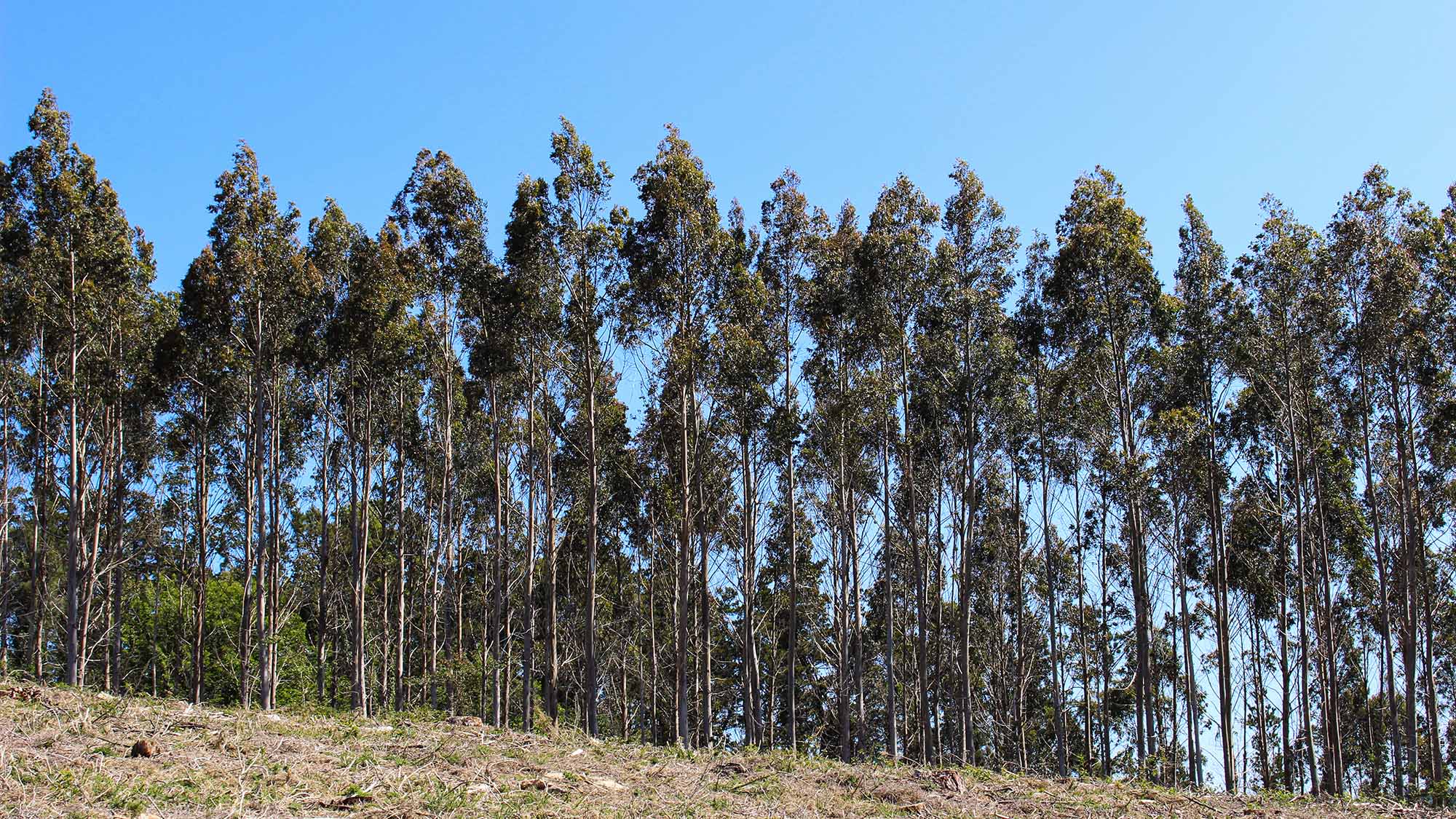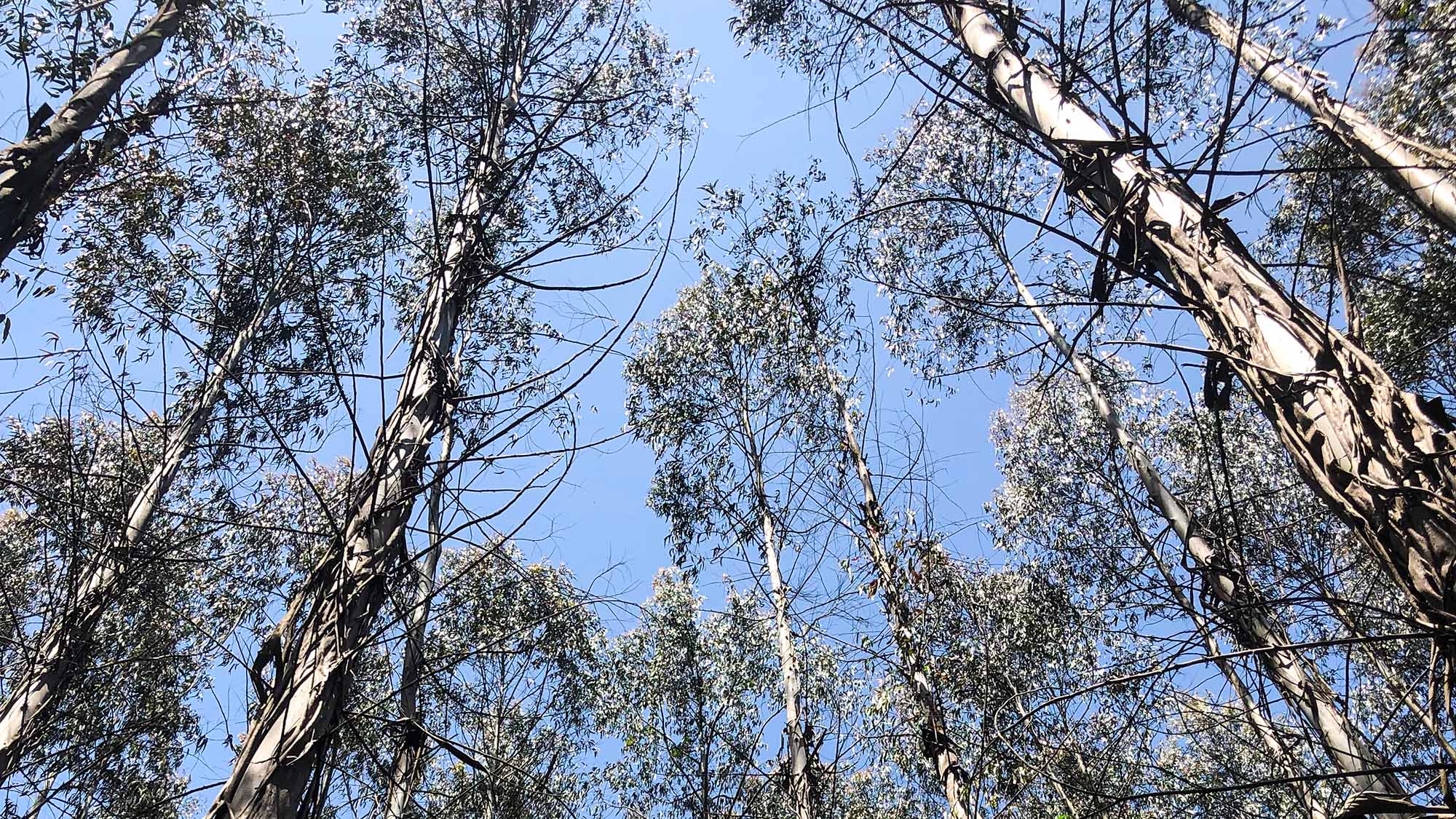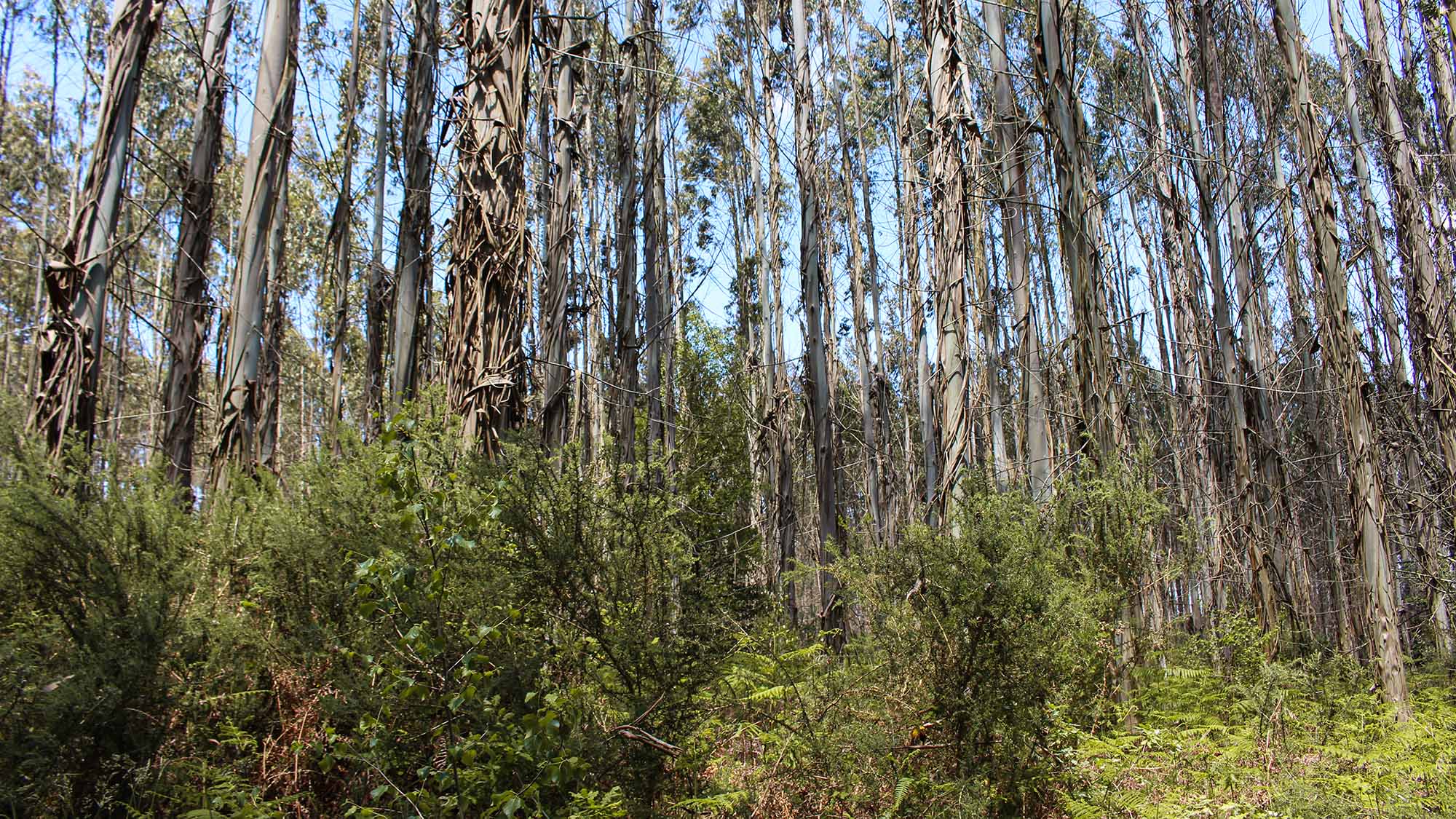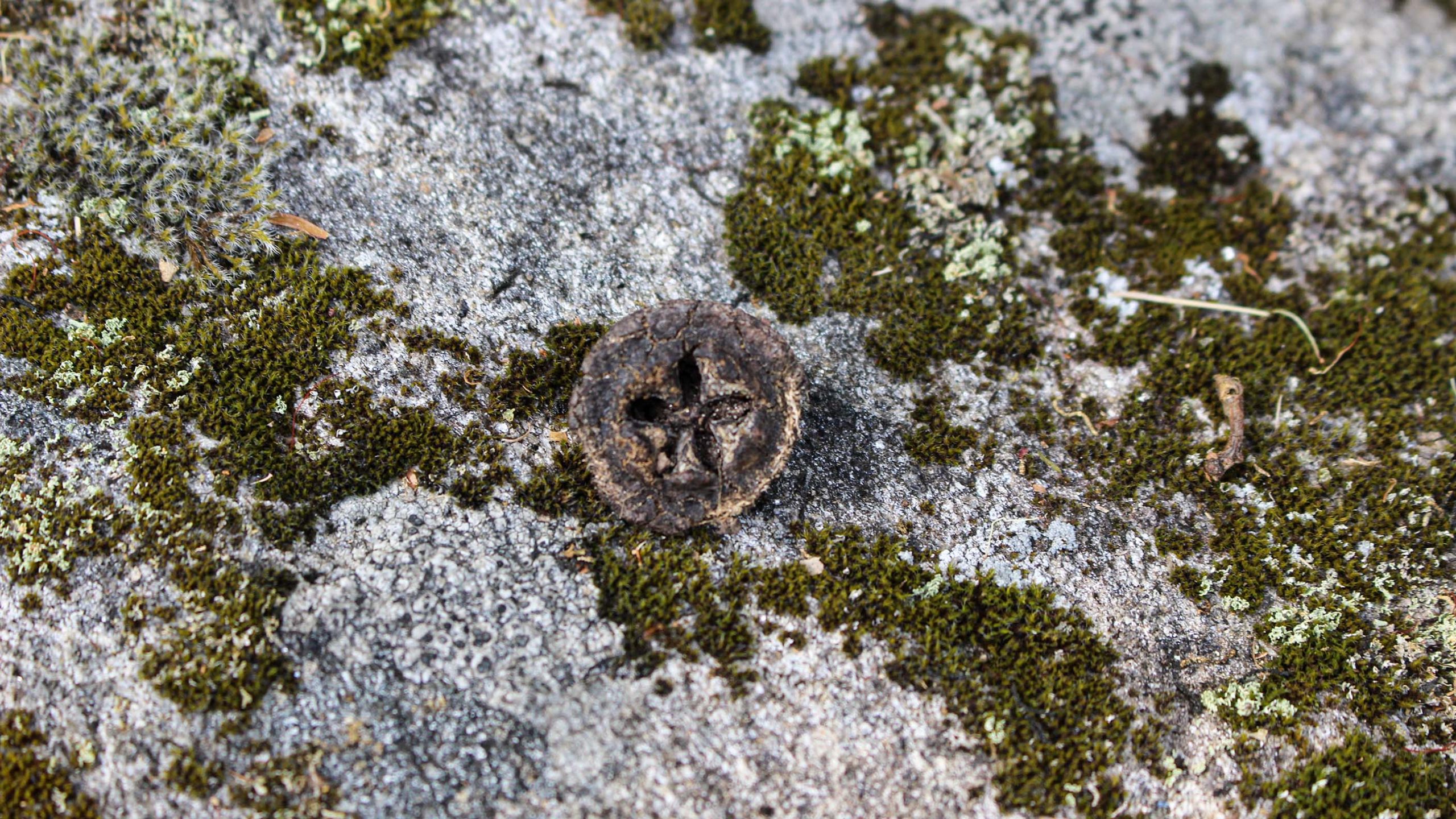Eucalyptus fever: speculation and wildfire in Galicia
Eucalyptus, a tree species that thrives on fire, now accounts for 28% of the forests in the Spanish region of Galicia. The situation has come about through the policies of the local Popular Party.
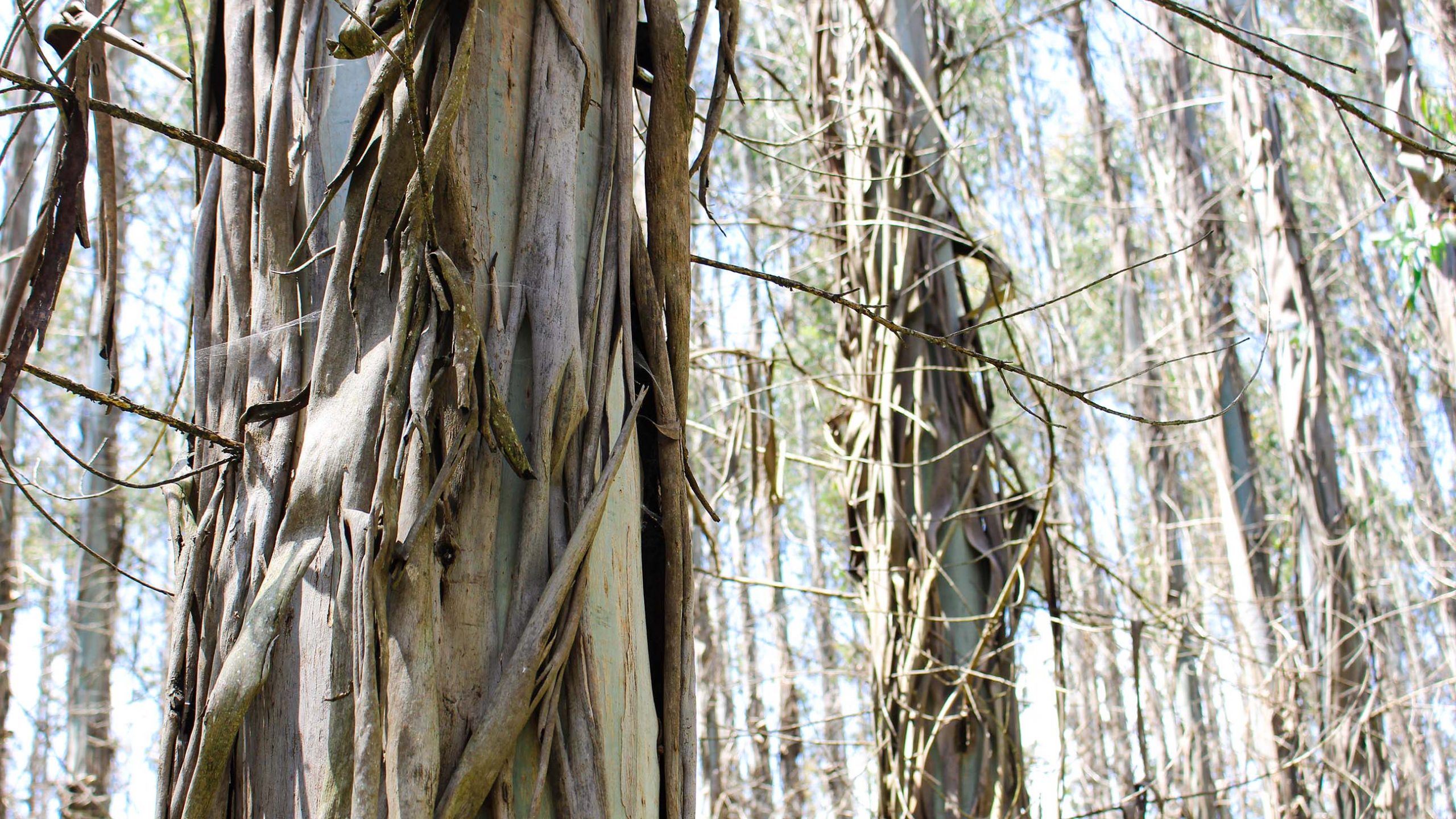
Galicia’s forests have been sold out. Every year they produce more than half of the timber cut in Spain, but in return a trap is being set: one of Europe’s most flammable regions is being filled with matchsticks. The green of the Atlantic forest, the oak and chestnut, is gradually being replaced by that of the eucalyptus, an exotic species that now makes up almost a third of the Galician forest biomass. Eucalyptus has an intimate relationship with fire.
“I planted it and things went very well”, exclaims Evaristo Rodríguez. With drawn eyes and walking stick in hand, at 83 years of age, Evaristo is standing in the middle of the Froxán massif, near A Coruña [in northwest Spain]. To get there you have to drive half an hour from Santiago de Compostela through a steep and lonely labyrinth of rural roads. “Nothing grows here like eucalyptus”, he adds, and he is right. In just fifteen years, the tree is ready to be felled and sold, yielding up to €2,500 per hectare per year. Pine, by contrast, needs almost three decades to grow to maturity.
But this Australian species has a darker side to it. One community-owned plot here became the nightmare of the locals when it suffered two serious fires in barely a decade, in 2006 and 2016. It is the great problem of the eucalyptus: the tree accumulates a lot of tinder at its base, it is flammable, and this can cause secondary outbreaks in windy conditions. Eucalyptus is a pyrophyte species: it needs fire to survive and reproduce.
“The residents of Froxán decided to cut down the eucalyptus and plant native species”, says José Cao, a forest fire warden. He cannot help but sigh when he looks around him and sees the work that still needs to be done. In barely a generation, eucalyptus has taken over the Galician forest. It already occupies an area similar to the province of Pontevedra, and contributes around 2% of the autonomous community’s GDP. It has done so thanks to the laxity of the regional governments of the Partido Popular (Popular Party, conservative) and the insatiable demand of Ence, the big Galician paper mill, whose main business is eucalyptus.
When asked about the future of his plantation, Evaristo grimaces: “Young people are not interested in the land, they don’t attach much importance to it.” He knows that his children will not take care of his trees, and his is not an isolated case. 36% of Galicia’s land is not easily exploitable, and the eucalyptus problem is being exacerbated by rural depopulation and the abandonment of farms, and by climate change. In response to questions from El Orden Mundial, even Ence acknowledges that “the neglect of land management is one of the main threats to the sector, if not the main threat”, and that “new plantations are not necessary”.
Without continuous maintenance, eucalyptus plantations become a powder keg.
The tree of discord
It is not easy to talk about eucalyptus in Galicia. The Xunta (regional government) – dominated by the Partido Popular for 36 of its 42 years of autonomy – has for a long time looked the other way. It has hardly even provided information on local trends. Its forestry policy has been guided only by a national inventory carried out by Spain’s Ministry for Ecological Transition and the Demographic Challenge, which reviews the state of Spanish forests once a decade.
“There is no doubt that the eucalyptus represents a source of wealth of enormous value for many Galician families and an important employment niche,” says José Luis Chan, the Xunta’s director general for forest planning and management. In his comments to us, he refused to “demonise any species”.

The lack of information has muddied the debate and allowed for the twisting of figures that are often out of date and mutually incomparable. In fact, the scarce data available shows that eucalyptus in Galicia does not cause fires beyond the land area it occupies itself. But it is nonetheless the species that poses the greatest risk in a large fire, both in terms of spread and extinguishing.
For a start, fire advances twice as fast in a eucalyptus grove as in a native oak forest. Although a pine fire spreads faster still, the eucalyptus is the only species capable of spreading flames over long distances, as can be seen from the Photoguide to Forest Fuels in Galicia, an extensive scientific work published in 2016. Despite this, in 2022 alone, Ence spent €236 million buying wood from eucalyptus plantations, which are generally in the hands of private individuals.
“Because of the morphology and oils of eucalyptus, fires tend to be more virulent and with wind they generate embers [travelling up to two kilometres] that can give rise to secondary outbreaks, which can then trap us,” says David López, brigade leader of the Mariña Lucense forest-fire brigade.
The Boiro fire in August last year is a case in point. It ravaged 220,000 hectares in the province of A Coruña and forced the evacuation of 700 people. The fire was started by a domestic chimney and soon climbed uphill, against the backdrop of the many summer festivals taking place in the area. But it was eucalyptus plantations, together with the slope and the dreaded north-easterly wind, that caused the fire to get out of control and spread to four municipalities.
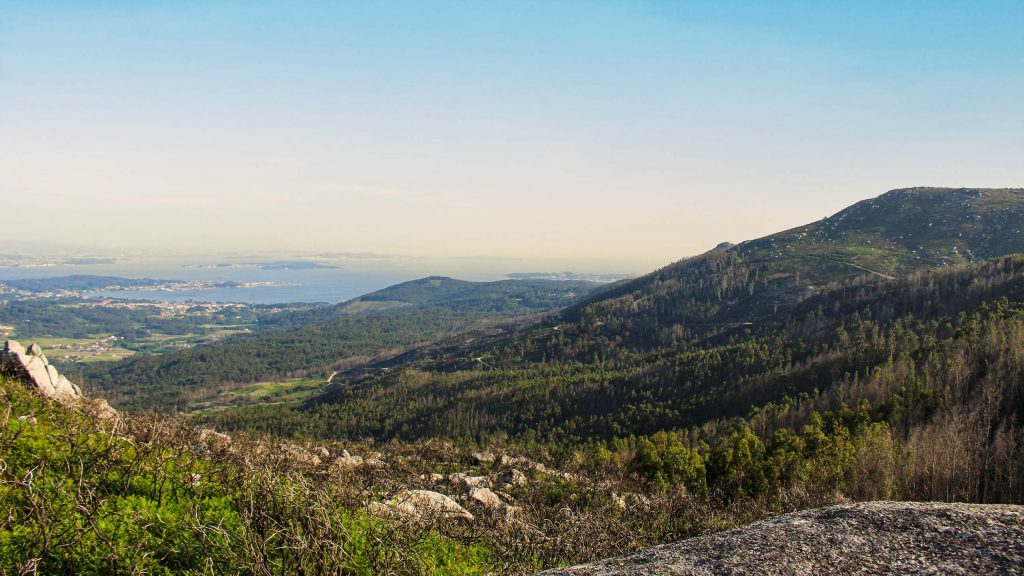
The burnt mountain of Boiro, with the Arousa ría in the background.
To grow quickly and tower over their competitors, eucalyptus trees – whose pulp is mainly used to make paper – need large amounts of light and water. They are elongated, straight trees that concentrate their growth in the crown. Their leaves have identical faces that turn in the wind and point downwards to make the best possible use of the sun’s rays.
The main consequence of this growth strategy is that the trees let in plenty of light and accumulate a lot of undergrowth at their base. In the summer heat, this vegetation dries out and becomes fuel along with the bark and fallen branches of the trees themselves.
“Fires in eucalyptus plantations are more difficult to control because in many cases the plantations are not properly managed and so we are faced with a lot of biomass,” explains firefighter David López. His colleague Ángel González, stationed in the town of Padrón, talks of “an eternal loop” in which the eucalyptus “modifies the soil, there is a fire, other species die, and it resprouts, colonising the open spaces”. But he insists that “the key is management”. The phrase is repeated by all the sources we consulted. But it has become difficult to put the idea into practice after decades of institutional inaction.
Under the government of the popular Manuel Fraga, the Xunta approved a forestry plan in 1992 which foresaw some 245,000 hectares of eucalyptus in Galicia by 2030. However, that figure was probably already exceeded by 1998, and in 2022 it had reached 409,026 hectares, or 28% of Galician forest mass. The aim has always been to supply wood to Ence, which has become the European leader in eucalyptus pulp production after being fully privatised in 2001. It exports the vast majority of its production.
The Xunta even defended the eucalyptus sector in the courts so as to prevent the species from being declared invasive in Spain, after a report by the Scientific Committee for the Environment recommended doing so. This consultative body (serving Spain’s autonomous communities and the agriculture ministry) mentioned the high risk of fires, the alteration of the ecosystem and the difficulty of eradicating the species.
As eucalyptus continued to march unchecked, Alberto Núñez Feijóo, head of the Galician government between 2009 and 2022, waited until 2021 to update the 1992 forestry plan. With the tree already occupying almost double the area planned for 2030, he set a reduction target of just 5% by 2040. Shortly afterwards the government also passed a moratorium to prevent new plantations up to 2026, although it excluded areas where plantations were already present. Feijóo went so far as to say that there is no “better pension plan” than the forestry sector.
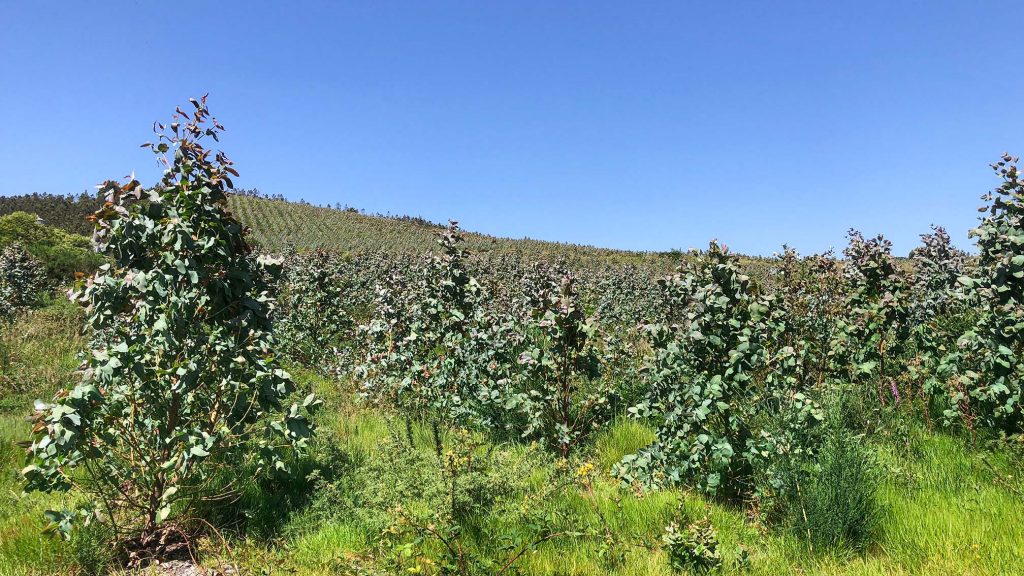
Illegal eucalyptus plantation on the outskirts of Padrón (A Coruña).
Following the announcement of the moratorium, many landowners rushed to cut down other trees and plant eucalyptus so that they might continue to do so in the future. And although the Xunta claims that it is monitoring respect for the law, it is enough to take a walk in rural Galicia to see that non-compliance is widespread. The current Galician regional president, Alfonso Rueda (also a conservative), declared in a press conference in June that the objective continues to be “to produce more, to sell more, and at better prices”.
This policy has led to eucalyptus taking over the Galician coast, the area with the most humid and temperate climate in the autonomous region.
In recent years, however, the arrival of a new subspecies resistant to colder temperatures – nitens instead of globulus – is allowing the tree to move inland. Climate change is increasing the intensity and frequency of fires. Meanwhile, nitens has put the intermediate zones of A Coruña and Lugo at risk.

In Galicia, eucalyptus plantations are concentrated on the coast and gradually disappear as one moves further inland. In the last two decades, however, fires have been more frequent in the southwestern half of the region.
So far, and thanks to the climate, Pontevedra is the only province where fire and eucalyptus have converged on a large scale. There, the neglect of the plantations is such that in some places the trees invade the roads. This can make it impossible to get out of the towns in the event of a blaze, according to local firefighters.
The Galician jungle
Near Ordes, on the outskirts of Santiago de Compostela, two empty detergent cans serve as a boundary between three plots of land, each barely ten metres wide. On the left, a mature eucalyptus plantation; in the centre, a more recent one from about two years ago; and on the right, an abandoned piece of land now turned into an oak grove. It is the very picture of Galician woodland, a mosaic of smallholdings (8% of which have no known owner).
In addition to the smallholding system [minifundismo] – Galicia is the Spanish region with the highest number of plots per owner and the smallest average area – Galician forests are heavily privatised. Only 3% of the land is public, the lowest rate in the country. To top it all off, Galicia is also the region with the highest annual wood growth, almost double the figure for the second region in the list, Castilla y León, according to figures from the environment ministry.

“With this background, it is easy to imagine the problems that can be caused by an invasive and highly combustibility species in a Galician forest frequently subject to forest fires,” says Alberte Blanco, who was the Xunta’s director general of forestry for the coalition government of his party, the Bloque Nacionalista Galego, and the PSOE in 2005-2009.
In his opinion, the great obstacle is “the absence of political will” of the Popular Party, which went so far as to subsidise eucalyptus plantations in the 1990s. The coalition government made it compulsory to clear undergrowth from around domestic perimetres and prohibited the planting of pine or eucalyptus near urban centres. But it too failed to halt the uncontrolled expansion of the species.
Beyond politics, land partitioning in Galicia determines the logistics of supplying Ence, which is forced to turn to private landowners to satisfy 95% of its demand for wood. In total, there are about 250,000 owners of eucalyptus plantations in Galicia, according to estimates by Unions Agrarias, a farmers’ union. That is equivalent to 9% of the population, so practically all Galicians know an owner who has received a call from Ence.
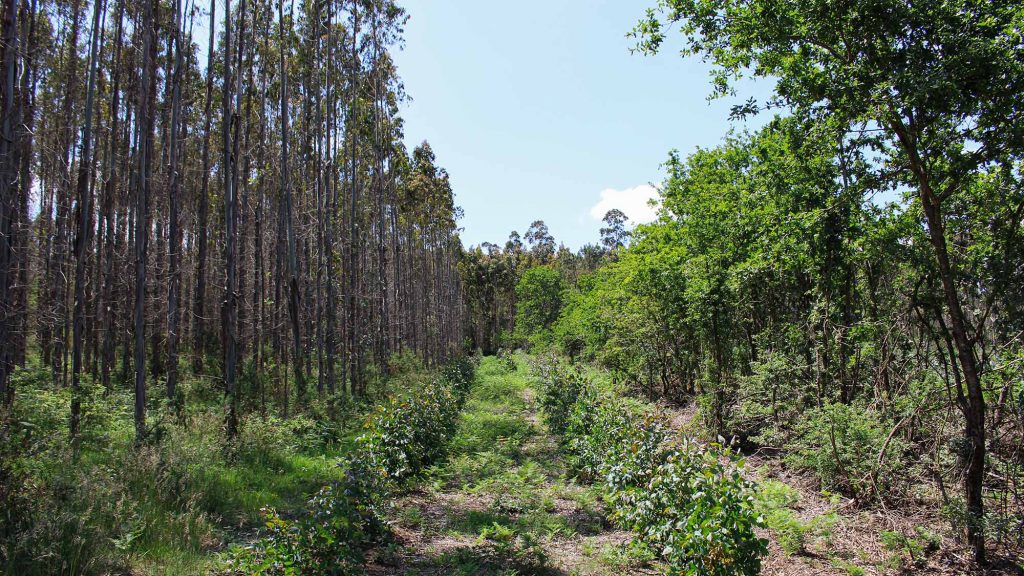
Land compartmentation near Ordes (A Coruña).
However, the fact that the company’s purchases benefit a large segment of the population has not made its business uncontroversial. Apart from promoting the eucalyptus plantations in Galicia, six Ence executives were convicted of environmental crime in 2002. The company is also known for its revolving doors: former environment ministers Isabel Tocino (1996-2000) and Carlos Del Álamo (1997-2003) have found their way onto its board of directors.
On the other hand, Ence almost had to abandon its factory located on public land in the Pontevedra estuary, where it contributes 28% of the provincial GDP. The concession was due to end in 2018, but in 2016 the incumbent government of Mariano Rajoy, a Galician and also from the PP, extended until 2073, despite discontent about the site’s odours and noise.
But now a new player is trying to change the rules of the game and threaten Ence’s hegemony: Navigator, which is neighbouring Portugal’s largest pulp mill and already controls nearly a thousand hectares of eucalyptus in Galicia. In Portugal, a wave of fires in 2017 led the government to decree a moratorium on new plantations until 2030, pushing Portuguese companies across the border to secure their supply. Unlike the Galician industry, which sends pulp abroad to be transformed into paper, Portugal controls the entire production chain and so has a more pressing demand for wood.
In the face of the Xunta’s inaction, there is a growing clamour from civil-society groups to roll back the eucalyptus monoculture. Their argument is that the tree not only increases the risk of major fires, but also reduces biodiversity and impoverishes the soil, by acidifying and drying it out. Xoán Manuel Pérez, a member of the environmental association Verdegaia, embodies this movement, which has a young and urban flavour. A resident of Santiago de Compostela, he works in a municipal library and dedicates his free time to protecting the Galician Atlantic forest.
In a eucalyptus grove near Padrón, amid the creaking of dry branches and rickety trunks waiting to be felled, Pérez thinks back to his childhood: “In the cork-oak grove where I grew up there are now only eucalyptus trees. The transformation of the forest has taken place in a human lifetime, when it used to take generations.” It is hard to believe that almost a third of the Galician forest has been replanted in just a few decades. After the wave of fires in 2017, his association created what they call “de-eucalyptus brigades”, teams of volunteers who clear plots of land belonging to those landowners who are concerned about the dangers of the species. In little more than five years they have already intervened on more than eighty sites, including the Froxán plot that burned in 2006 and 2016.
In addition to organisations such as Verdegaia, local academia is also working to put numbers to the eucalyptus problem in Galicia. The upcoming Continuous Forest Inventory of Galicia, a project of the Xunta in collaboration with the universities of Vigo and Santiago, aims to make up for the lack of data. The environment ministry, which should provide such data, is running two years behind schedule.

According to Juan Picos, director of the School of Forestry Engineering at the University of Vigo and coordinator of the project, the inventory will mark “a before and after” in forest management in Galicia. Not only will it put much-needed numbers on the problem of eucalyptus in the region, but it will also allow the plant’s spread to be monitored, plot by plot and year by year.
Backed up by an investment of more than €3 million, the first results – including some of the figures in this report – were published in early June. The more detailed data yet to be published will give a good account of how and where eucalyptus is on the move. For the Vigo academic, who is well-respected in his field, the data will help to identify areas of high fire risk where “it would make sense to eliminate” eucalyptus.
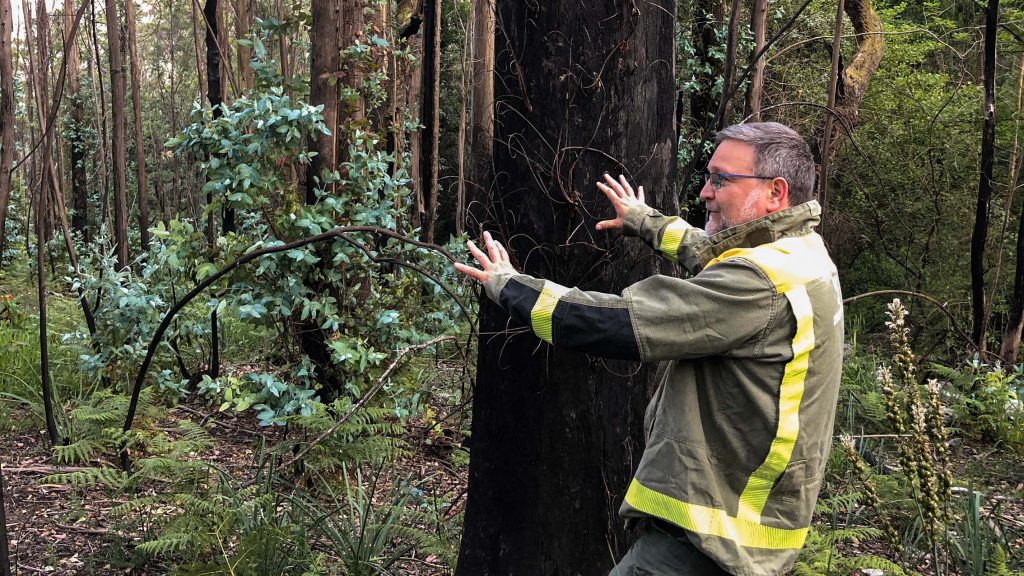
Juan Picos describing the fire in Boiro.
An inherited conviction
He might be over eighty years old, but Evaristo continues to tend his eucalyptus trees. He knows that if he neglects them they could easily become the fuel for a fire. He comes from a generation accustomed to managing and nurturing the forest – and keeping one step ahead of fire. But his children no longer live in the same Galicia. Nature looks set to reclaim his plantation like many others, without resistance.
With almost 4,000 empty villages, an average age of 48 and a passive attitude towards forestry, Galicia is at the mercy of feral eucalyptus and the fire that comes with it. Climate change is exacerbating things: recent fires have helped this hardy tree to eliminate competition from native species, which are weaker after hot summers. After decades of institutional neglect and land profiteering, the vicious circle of eucalyptus means an accident is waiting to happen in the Galician forest.
Methodology
Data on timber harvests were taken from the Anuario de Estadística Forestal of the Ministry for Ecological Transition and the Demographic Challenge; data on eucalyptus area from the Inventario Forestal Nacional and the Inventario Forestal Continuo de Galicia; data on fires from the European Active Fire Detection scheme; and data on ownership of forest plots from regional reports and publications. In all cases, the latest year with available information was used.
For the graph showing the trends in eucalyptus in Galicia, we chose to use a range to show the results of annual forest inventories 1, 2, 3 and 4, insofar as they calculate pure and mixed eucalyptus stands separately and do not provide an estimate of the total area of the species. Also, the map reflecting the geographical expansion of eucalyptus is based on the results of the fourth inventory (2009), as the Xunta has only published the preliminary figures of the Continuous Forest Inventory of Galicia and has refused to share the cartographic data with El Orden Mundial.
This article was produced in the framework of FIRE-RES, a Horizon2020 project co-funded by the European Union focusing on extreme wildfires in Europe.
Original source: https://elordenmundial.com/fiebre-eucalipto-especulacion-fuego-galicia
 This material is published in the context of the "FIRE-RES" project co-funded by the European Union (EU). The EU is in no way responsible for the information or views expressed within the framework of the project. Responsibility for the content lies solely with EDJNet. Go to the FIRE-RES page
This material is published in the context of the "FIRE-RES" project co-funded by the European Union (EU). The EU is in no way responsible for the information or views expressed within the framework of the project. Responsibility for the content lies solely with EDJNet. Go to the FIRE-RES page

